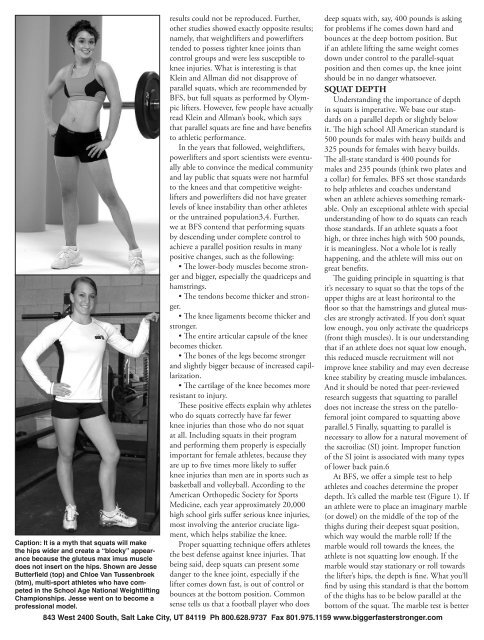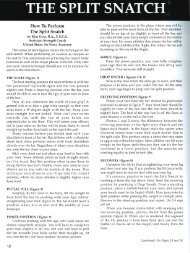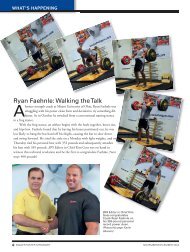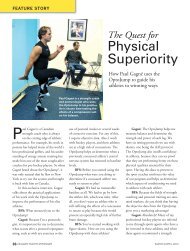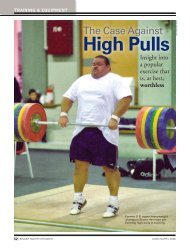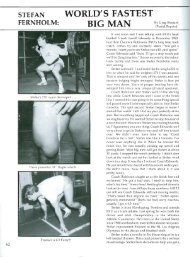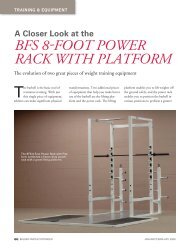POSITION PAPER • The Parrallel Squat - Bigger Faster Stronger
POSITION PAPER • The Parrallel Squat - Bigger Faster Stronger
POSITION PAPER • The Parrallel Squat - Bigger Faster Stronger
You also want an ePaper? Increase the reach of your titles
YUMPU automatically turns print PDFs into web optimized ePapers that Google loves.
Caption: It is a myth that squats will make<br />
the hips wider and create a “blocky” appearance<br />
because the gluteus max imus muscle<br />
does not insert on the hips. Shown are Jesse<br />
Butterfield (top) and Chloe Van Tussenbroek<br />
(btm), multi-sport athletes who have competed<br />
in the School Age National Weightlifting<br />
Championships. Jesse went on to become a<br />
professional model.<br />
results could not be reproduced. Further,<br />
other studies showed exactly opposite results;<br />
namely, that weightlifters and powerlifters<br />
tended to possess tighter knee joints than<br />
control groups and were less susceptible to<br />
knee injuries. What is interesting is that<br />
Klein and Allman did not disapprove of<br />
parallel squats, which are recommended by<br />
BFS, but full squats as performed by Olympic<br />
lifters. However, few people have actually<br />
read Klein and Allman’s book, which says<br />
that parallel squats are fine and have benefits<br />
to athletic performance.<br />
In the years that followed, weightlifters,<br />
powerlifters and sport scientists were eventually<br />
able to convince the medical community<br />
and lay public that squats were not harmful<br />
to the knees and that competitive weightlifters<br />
and powerlifters did not have greater<br />
levels of knee instability than other athletes<br />
or the untrained population3,4. Further,<br />
we at BFS contend that performing squats<br />
by descending under complete control to<br />
achieve a parallel position results in many<br />
positive changes, such as the following:<br />
<strong>•</strong> <strong>The</strong> lower-body muscles become stronger<br />
and bigger, especially the quadriceps and<br />
hamstrings.<br />
<strong>•</strong> <strong>The</strong> tendons become thicker and stronger.<br />
<strong>•</strong> <strong>The</strong> knee ligaments become thicker and<br />
stronger.<br />
<strong>•</strong> <strong>The</strong> entire articular capsule of the knee<br />
becomes thicker.<br />
<strong>•</strong> <strong>The</strong> bones of the legs become stronger<br />
and slightly bigger because of increased capillarization.<br />
<strong>•</strong> <strong>The</strong> cartilage of the knee becomes more<br />
resistant to injury.<br />
<strong>The</strong>se positive effects explain why athletes<br />
who do squats correctly have far fewer<br />
knee injuries than those who do not squat<br />
at all. Including squats in their program<br />
and performing them properly is especially<br />
important for female athletes, because they<br />
are up to five times more likely to suffer<br />
knee injuries than men are in sports such as<br />
basketball and volleyball. According to the<br />
American Orthopedic Society for Sports<br />
Medicine, each year approximately 20,000<br />
high school girls suffer serious knee injuries,<br />
most involving the anterior cruciate ligament,<br />
which helps stabilize the knee.<br />
Proper squatting technique offers athletes<br />
the best defense against knee injuries. That<br />
being said, deep squats can present some<br />
danger to the knee joint, especially if the<br />
lifter comes down fast, is out of control or<br />
bounces at the bottom position. Common<br />
sense tells us that a football player who does<br />
deep squats with, say, 400 pounds is asking<br />
for problems if he comes down hard and<br />
bounces at the deep bottom position. But<br />
if an athlete lifting the same weight comes<br />
down under control to the parallel-squat<br />
position and then comes up, the knee joint<br />
should be in no danger whatsoever.<br />
SQUAT DEPTH<br />
Understanding the importance of depth<br />
in squats is imperative. We base our standards<br />
on a parallel depth or slightly below<br />
it. <strong>The</strong> high school All American standard is<br />
500 pounds for males with heavy builds and<br />
325 pounds for females with heavy builds.<br />
<strong>The</strong> all-state standard is 400 pounds for<br />
males and 235 pounds (think two plates and<br />
a collar) for females. BFS set those standards<br />
to help athletes and coaches understand<br />
when an athlete achieves something remarkable.<br />
Only an exceptional athlete with special<br />
understanding of how to do squats can reach<br />
those standards. If an athlete squats a foot<br />
high, or three inches high with 500 pounds,<br />
it is meaningless. Not a whole lot is really<br />
happening, and the athlete will miss out on<br />
great benefits.<br />
<strong>The</strong> guiding principle in squatting is that<br />
it’s necessary to squat so that the tops of the<br />
upper thighs are at least horizontal to the<br />
floor so that the hamstrings and gluteal muscles<br />
are strongly activated. If you don’t squat<br />
low enough, you only activate the quadriceps<br />
(front thigh muscles). It is our understanding<br />
that if an athlete does not squat low enough,<br />
this reduced muscle recruitment will not<br />
improve knee stability and may even decrease<br />
knee stability by creating muscle imbalances.<br />
And it should be noted that peer-reviewed<br />
research suggests that squatting to parallel<br />
does not increase the stress on the patellofemoral<br />
joint compared to squatting above<br />
parallel.5 Finally, squatting to parallel is<br />
necessary to allow for a natural movement of<br />
the sacroiliac (SI) joint. Improper function<br />
of the SI joint is associated with many types<br />
of lower back pain.6<br />
At BFS, we offer a simple test to help<br />
athletes and coaches determine the proper<br />
depth. It’s called the marble test (Figure 1). If<br />
an athlete were to place an imaginary marble<br />
(or dowel) on the middle of the top of the<br />
thighs during their deepest squat position,<br />
which way would the marble roll? If the<br />
marble would roll towards the knees, the<br />
athlete is not squatting low enough. If the<br />
marble would stay stationary or roll towards<br />
the lifter’s hips, the depth is fine. What you’ll<br />
find by using this standard is that the bottom<br />
of the thighs has to be below parallel at the<br />
bottom of the squat. <strong>The</strong> marble test is better<br />
843 West 2400 South, Salt Lake City, UT 84119 Ph 800.628.9737 Fax 801.975.1159 www.biggerfasterstronger.com


